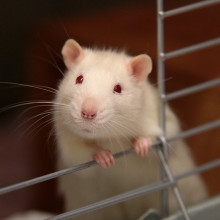Transplanting brain cells & the Big Birdwatch
Brain implants grown in a lab wire themselves into the nervous system. Artificial intelligence joins the search for extraterrestrial intelligence. We take part in the Big Garden Birdwatch 2023. And are sugar taxes actually effective ways to fight the obesity epidemic
In this episode

00:55 - Grown brain tissue transplant success
Grown brain tissue transplant success
Isaac Chen, University of Pennsylvania
Up first this week, there's renewed hope for the millions of people affected by brain injuries and degenerative diseases: scientists have successfully grafted new lab-grown brain tissue into the brains of rats and shown that the new tissue wires itself into the host brain and responds electrically to signals from elsewhere in the animal's nervous system. Although scientists have demonstrated over many years that new cells can be added to the brain, this is one of the first studies to show that the implanted tissue can grow, develop a blood supply and connect functionally. Neurosurgeon Isaac Chen, from the Uni of Pennsylvania started by using human blood stem cells to grow mini brains called organoids in the lab, which he then transplanted into recipient rats...
Isaac - An organoid is basically something we make in the lab that resembles the organ that it's supposed to look like. So, for instance, there can be lung organoids, intestinal organoids, kidney organoids, and in our case, what we're looking at were brain organoids that we form from stem cells that we can get from the blood of any human being. We give it a recipe of different growth factors and other things in the media that allow it to become something that looks like a mini brain.
Chris - And when you do this - because brain tissue it's a complicated tissue, it's not just nerve cells, there's a whole assemblage of different cell types in there - you get something resembling a piece of brain with all the right cell types?
Isaac - You get a lot of the different cell types. It's actually quite amazing the diversity of cell types that you are able to create. And it's not a perfect replica of the brain, but it's as good as we can do right now with the technology that we have, which is why we chose to look at this as what we transplanted.
Chris - And how did you transplant it?
Isaac - I'm a neurosurgeon, so I've been able to train my lab to do brain surgery on rats. What we did first was we took a piece of the skull off, used simple vacuum suction to create a hole in the brain, we took an organoid and we gently laid it within that hole in the brain and then we close things up.
Chris - So you end up with human brain tissue in this cavity you've made in the recipient rat brain. Presumably you were able to follow up these animals for a period of time afterwards to see what the tissue did?
Isaac - That's right. So we went out to upwards of three months after we did the transplantation of the organoid. And we were specifically interested in looking at how the neurons of the organoid those nerve cells are able to integrate with the brain of the animal, both structurally as well as functionally. We did a variety of experiments to look at those aspects of integration.
Chris - Are they actually wiring themselves in because that's the sort of the thing you're testing effectively, isn't it? Is this becoming a meaningful brain area that can contribute to brain function?
Isaac - Yes. And so that's what was really cool about the work. We were looking at whether or not the neurons got wired in, in a couple of different ways. We were able to use a modified virus to look at connections between the organoid and the brain. In a really cool experiment that we did, we injected a virus into the eye of the animal and we were able to show that there was a direct connection, a pathway that formed between the eye of the animal and the organoid that we had transplanted. So that gave us evidence that there was a structural connection between the visual system of the animal and the organoid. The eye is actually part of the brain, and so it was really cool to be able to see that the eye was directly connected with the organoid. The other thing we ended up doing was to stimulate the animal with different types of flashing light and other patterns of light, and seeing what types of electrical responses were present in the organoid itself. And we found that there were very specific electrical responses that showed up in the presence of the stimulation. And so this gave us a sense that there was a functional connection between the organoid and the animal's brain as well.
Chris - And presumably the reason you are interested in doing this is that in human brain trauma or because of degenerative conditions, the best way to remedy that is to put new tissue back. And this is the first step really to testing, if we make and engineer tissue in a dish as a replacement, can it actually be meaningfully implanted into the brain and have some prospect of surviving and contributing to brain activity?
Isaac - That's right. Our brains are not able to do a lot to repair to itself after some sort of an injury, which is why patients with brain injuries and strokes and other types of conditions have neurological deficits. So yes, this is start of the road to try to understand, can we create something in a lab, some sort of a tissue that resembles the brain that we can then insert into the brain of a patient with a problem and be able to allow them to restore function?
Chris - Rats are obviously not humans, they're also much smaller. And if we're talking about the size of a human brain and the size of a likely implant you'd need to fix a damaged bit of brain, we're talking about possibly an order of magnitude or more of scale up. Do you think this will work if we were to try and scale it up in that way in a human?
Isaac - There's a lot that we have to figure out before we're ready to proceed with something like this in a patient. But there is a path that I can foresee where we do not necessarily need to scale up the tissue itself. There are parts of the brain where it's structured like a lot of repetitive processors. And in this case, by inserting smaller clumps of tissue, you could be adding processors to the brain in very specific areas where it's been damaged. And you don't necessarily have to replace the whole cavity, let's say, of a stroke or an injury, a brain injury, something like that. But you could insert smaller pieces of tissue that can effectively increase the computational capacity of that particular area of the brain. And because we understand the brain more and more as a network, these smaller fixes might be able to improve the function of that brain to the point where there's recovery of function for the patient.

07:26 - Machine learning helps hunt for ET
Machine learning helps hunt for ET
Peter Ma & Cherry Ng, University of Toronto
The global community dedicated to searching space for signs of aliens, SETI, the Search for ExtraTerrestrial Life, works under the assumption that we’re looking for signs of technology - a proxy for intelligence. The kinds of technology they search for include radio transmissions, which a sophisticated civilization similar to us would probably have made use of as a fast means of communication. The search for these signals is hampered, however, by false positive results returned from man-made radio signals which blind telescopes pointing at far away stars. Now, a team at the University of Toronto has developed a machine learning algorithm capable of combing through the thousands of signals of interest SETI telescopes return to reduce these pesky false positives, and can look for patterns in radio signals other algorithms miss. I spoke with Cherry Ng and Peter Ma to hear how they’ve done it…
Peter - Machine learning approaches problems in a unique way. It looks for patterns in the data without being instructed what the actual patterns are. So traditional algorithms are like baking a cake: you have a set of instructions which you follow to execute this process. That's if you know what you want to look for. In this case, we want to look for specific kinds of signals but, for ET, we don't actually know what exactly they're going to send us. And so what we want to do is we actually want to get the computer to decide different kinds of anomalies that are detected in our data by using machine learning. We're casting a wider net than we have ever done before with traditional algorithms. You can think of traditional algorithms as like preset conditions of things that I exactly want to look for and have to meet exactly to register as a hit or register as a potentially positive event. But for machine learning, it makes none of those assumptions and it just makes these decisions based on the data it has seen. And we've trained on hundreds and hundreds of thousands of examples such that when it does look at this data, it can make decisions based on what's actually out there.
James - So in terms of how much laborious work, how many hours you're able to save as a result of this new method, are we talking order of magnitude more efficient?
Peter - For my algorithm, it runs almost twice as fast as it takes to observe. In other words, if it takes 30 minutes to observe, it takes like 15 minutes to process or like 18 minutes-ish to process the actual data. The classic algorithm or what we call turboSETI, at least by the time when I was writing this paper, took almost an hour to run through the same piece of data. So it is significantly faster.
Cherry - Peter's machine learning algorithm is a lot faster. We were able to process the entire 800 star data set in like two weeks and with very modest computing resources. So indeed, one huge advantage of the machine learning algorithm is that we can search a much larger parameter of space than what a traditional algorithm might be able to do just because it's so much more efficient.
James - And I know this is not your guys' area necessarily, but indulge me a bit. What's the protocol for if we find some radio signal from space? If all this work bears some fruit and we find something that isn't man-made, what then?
Cherry - Yeah, I think what people say is an extraordinary claim requires extraordinary evidence. If we do find something interesting, the first most important thing is to confirm it, to be really sure that it is a genuine signal. And the only way to find out is by re-observing and re-detecting it also with different telescopes by involving other scientists to see if we can independently confirm these signals and then try to extract as much information from the data we have as possible. Is it from an exo planet? Can we find out about the radio velocity or any other information? And then if we are really sure, then I think it requires international collaboration to try and come up with a coherent plan of how to establish any communication.

Big Garden Birdwatch 2023
Richard Morris, RSPB
The Big Garden Birdwatch, an RSPB-led initiative to track the distribution and population of our bird numbers, is UK’s biggest piece of wildlife citizen science and took place last weekend. Twitchers were asked to tot up how many birds and of what species they spotted over a one hour period. The initiative began in 1979 as a feature on the children’s TV show “Blue Peter”, but has grown enormously in popularity since. Last year, 700,000 people across the UK took part and collectively counted more than 11 million birds. Will Tingle and our own appropriately named James Tytko have joined in too!
Will - And a lot of people now are migrating towards cities, more urban areas where perhaps there's less bird life than out in the country. What do you say to the people that live in urban areas that might think there's no reason to participate?
Richard - The thing with the birdwatch, you don't need a garden to take part. I mean, you can do it in a park, you can do it in a green space from your balcony. I was down at my local canal yesterday, so you don't need to be in the countryside or have a large garden to take part. And all the data's helpful to us. Even if you don't see anything during your hour, put together with everybody else's results it helps us to get a really good snapshot.
Will - There we go. We're kicking off strong. Got a couple of blue tits there.
James - Where? Oh yeah, I see him now.
Will - Lovely. A stallwart of the garden watch survey. Oh, it's a black bird. A black bird, James. We're kicking it up a notch. Very exciting. Two black birds. Three. I don't know about you, but my heart is going again. I'm hearing a lot. I'm not seeing a lot.
James - Oh, I can, I can see it on the tree. Well over there. Yes.
Will - That counts, right?
James - Well, come on.
Will - I see it. We'll take it. Oh, is that a wren? It is. I cannot believe this. James has just gone inside and there's a buzzard.
Will - Are there any other things that people can do with their gardens to improve the quality of their birds and their bird populations?
Richard - There are lots of simple things you can do if you have a garden yourself from putting some bird food out, feeding stations, and water as well. Important to remember that cleaning and hygiene is really important. So if you are feeding birds, then make sure that the feeders are cleaned regularly and there's fresh water going out daily and that helps stop the spread of diseases that we know can impact some species. Also, leaving scrubby areas in your garden is great for the nesting, roosting and giving birds shelter and cover from the weather as well. Things like leaving your grass a bit longer in some places - really good for insects, which are a source of food for birds as well, not using insecticides and things like wildlife friendly planting. These are all simple things you can do and can make a real benefit for the birds and bring more nature into your garden as well.
Richard - Another thing is that the birdwatch is good for us as well as for wildlife. Getting out into nature and connecting with the nature on your doorstep is really good for mental health and wellbeing. We did a YouGov survey as part of this year's birdwatch, and it showed that from the people we asked, 9 out of 10 people agreed that listening to birdsong, going out and watching birds, benefited their mental health and wellbeing. So really positive impacts for people to get out there and enjoy the nature that's on the doorstep.
Will - Do you feel any less stressed at the moment right now, James?
James - Yeah, I'd say so. It's nice to take a break. I mean, I'm a big believer anyway in getting out in nature if you're feeling a bit low, so absolutely happy to be here.
Will - Well, we end today on three blue tits, three jackdaws, three blackbirds, a buzzard, a wren, and a robin. It's not quite the goldfinches and bluefinches that we've seen here in days gone by, but not bad. Not bad for an hour in January. So how do you think today went?
James - I was delighted actually with our haul. About four or five different species. I'm well happy with that.
Will - Good. And I hope everyone had equal success or equal happiness at their success when they did theirs at home.
Richard - One of the great things about the big garden bird watches is that it's for everybody. You don't need to be a bird expert to take part, but it can be a great introduction to the species that are there that you might perhaps not notice until you sit down for an hour and just start to look around you. And the more that you do it and get out in nature and start to appreciate what is there, the greater the connection is and just being out in the fresh air, taking notice of what's around you, it has a really positive impact and is a nice escape from day to day things that you have to deal with all.

19:57 - Sugar tax proving effective
Sugar tax proving effective
Jean Adams, University of Cambridge
According to the 2021 Health Survey for England, almost three quarters of UK adults are overweight or obese, with obesity rates doubling in the last 30 years. Apart from this being an alarming trend in its own right, the evidence is that young children are also affected, with roughly a third of 10 and 11 year olds overweight or obese. And as they grow up, these children are likely to remain overweight adding to the prevalence of obesity within the population. It's the biggest risk factor for conditions like diabetes and heart disease, which now cost the health service billions every year.
Sugar consumption has been blamed as a major culprit, and most teenagers are typically consuming over 70g of refined sugars every day - that's double the recommended amount. Most of the intake is coming from sugar-sweetened drinks. This is what prompted the government to introduce a "sugar tax" in 2018 to penalise manufacturers based on how much sugar they put in their beverages. So has this intervention worked? Jean Adams from the Cambridge MRC Epidemiology Unit has been looking at the impact on school-age children.
She’s analysed data from the National Child Measurement Programme on over 1 million children in reception - that's 4 to 5 years old - and year 6 - that's 10 to 11 years old - in English primary schools. The introduction of the sugar tax, she's found, was associated with an 8% relative reduction in obesity levels in year six girls; this is equivalent to preventing 5,234 cases of obesity per year in this group. The reductions were greatest in girls whose schools were in deprived areas, where children are known to consume the largest amount of sugary drinks. Surprisingly, boys though showed no change in obesity rates...
<>Jean - We have about 50 countries or territories around the world which now have a tax on soft drinks or sugary drinks. And there is now quite a lot of evidence that they lead to reductions in purchasing and consumption of the drinks that are taxed. There's less data so far on impacts on hard health outcomes. So this study that we've done on obesity in children is kind of leading the way there.
James - Okay. So the signs are good, the tax is making a difference, but how do you know for sure that it's the sugar tax doing this and not other things? Messaging? Education?
Jean - Yeah, that's a really good question and it is really difficult to untangle these things. It's very difficult to get clear signals from this sort of policy evaluation where we're looking in the real world rather than doing controlled trials. And I guess there's a number of ways to think about that and one might be that the messaging and the education is part of what the tax is. So when we introduce a tax that comes along with a lot of discussion in the media, in other places about why is the government taxing soft drinks, well that's because they think they're not very good for you. And so we can think of that whole package of measures as part of what the tax is, but also the methods that we've used where we look at trends over time and how those change in relation to when the tax was implemented. A real problem with that sort of method is it is vulnerable to other things happening.
Jean - So we can't say for absolute certain the tax has led to the change in obesity levels that we see, but we can say that it's part of a jigsaw of lots of different pieces of emerging evidence. So we saw that coincident with the tax coming in, we saw changes in the amount of sugar that was in drinks and that reflects that the tax encouraged manufacturers to reduce the sugar in their drinks. And we also saw decreases in purchasing of sugarery drinks. So all these things together make us think that there's a story to be told.
James - Sure. Just to rewind back a bit slightly. Have you got numbers to put on this as to how exactly important the tax was in reducing sugar intake in kids?
Jean - We have not yet looked at sugar intake in totality, we've looked at purchasing of drinks in households and we see a reduction there in the kind of 5% range.
James - And is it affecting everyone the same? Boys, girls why the difference there? I mean, perhaps you don't have the answer for me right now, but could you speculate as to why you're seeing that difference?
Jean - Yeah, we don't know the answer to that and this data doesn't tell us. So it really is speculation. But I guess we all know that we live in society where girls and boys experience life differently. So girls may be primed to be more responsive to messages about what they're eating, what they look like. Boys might be more primed to messaging about what it is to be good at sport and how energy drinks play into that.
Related Content
- Previous Good Luck
- Next Satellites: forging metal and finding cholera










Comments
Add a comment